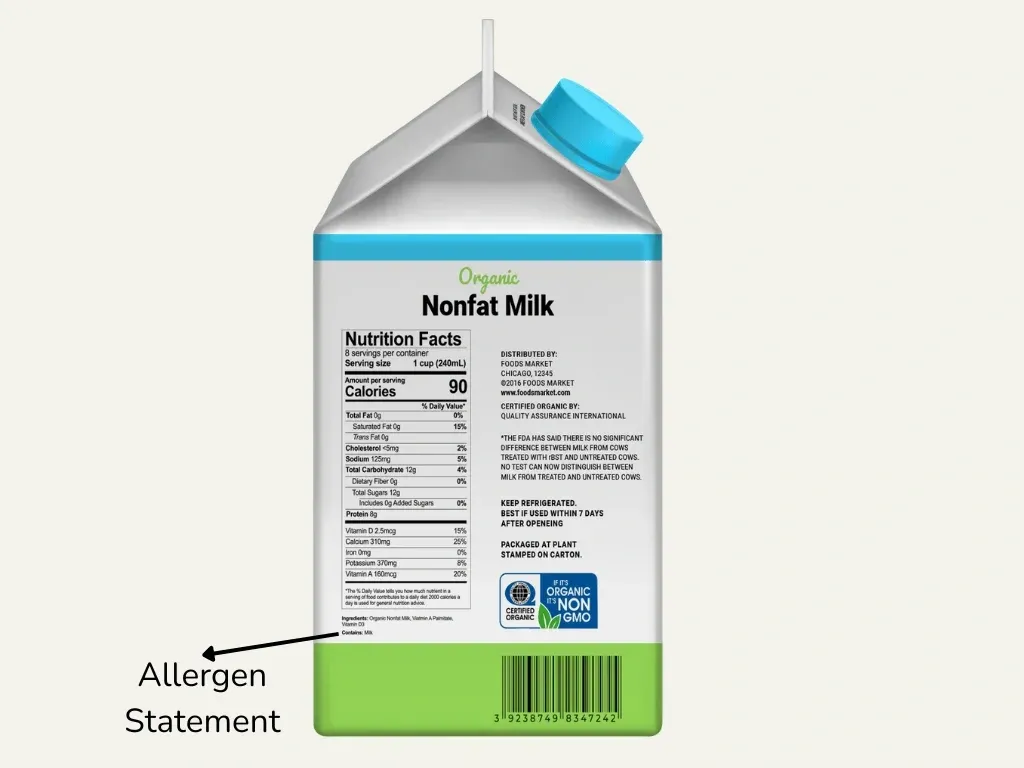Discover which ingredients to avoid if you have a sesame allergy. Stay safe with the latest 2025 food safety tips and allergy-friendly grocery advice.
2025 Guide: Ingredients to Avoid if You Have a Sesame Allergy – Smart Food Safety & Label Tips
Learn which ingredients to avoid if you have a sesame allergy. Stay safe with 2025 food safety tips, allergy label updates, and trending advice.
Sesame Allergy Alert: Top Ingredients to Avoid for Safe, Allergy-Friendly Meals in 2025
Discover which ingredients to avoid if you have a sesame allergy. Stay safe with the latest 2024–2025 food safety tips and allergy-friendly choices.
How to Scan Food for Allergens: 2025 Food Safety Tips & Allergy-Safe Shopping
Scan your food for allergens with smart tech! Stay safe and confident with 2025’s top food safety trends and allergy-aware shopping tips.
How to Spot Hidden Food Allergens: A Life-Saving Label Guide
How to Spot Hidden Food Allergens: A Life-Saving Label Guide Did you know that just eight common food allergens cause 90% of food allergies and serious allergic reactions in the U.S.? These everyday ingredients can trigger reactions within minutes – from mild hives to life-threatening anaphylaxis. Reading labels becomes a vital safety practice if you have food allergies. The FDA requires clear labeling of the “Big 9” major food allergens: milk, eggs, fish, crustacean shellfish, tree nuts, peanuts, wheat, soybeans, and sesame (added recently). Yet concerns remain. Scientists have identified more than 160 foods that can trigger allergic reactions in sensitive people. Many products contain hidden allergens that aren’t obvious on the packaging. The FDA’s data shows that undeclared allergens caused about one-third of reported serious health risks, with milk leading food recalls. The risk extends beyond food labels. Products not regulated by the FDA, such as cosmetics and personal care items, can contain allergens too. This makes watchfulness essential. Apps like Yuka and Food Scan Genius help identify potential allergens faster. This detailed piece shows you how to spot hidden food allergens, understand confusing label terms, and keep yourself and your loved ones safe from dangerous allergic reactions. Why Reading Food Labels Can Save Your Life More than 15 million Americans with food allergies know that reading labels isn’t just helpful—it could save their lives [1]. Your body’s encounter with an allergen can trigger reactions ranging from uncomfortable to deadly within minutes. Why Reading Food Labels Can Save Your Life A quick check of ingredients before eating could mean the difference between safety and rushing to the emergency room. April Clark, a registered dietitian at the Food Allergy Center, emphasizes that “reading and understanding food labels is one of the most important things parents of children with food allergies can do” [1]. How food allergens trigger reactions Your immune system mistakenly flags specific food proteins as harmful during an allergic reaction. Your body creates immunoglobulin E (IgE) antibodies that recognize that specific allergen [2]. Even a tiny amount of that food triggers these antibodies to alert your immune system, which releases histamine and other chemicals into your bloodstream [2]. These chemicals cause allergic reaction symptoms. Your body might react in several ways: Skin reactions: Hives, flushed skin, or rash [3] Digestive issues: Vomiting, diarrhea, and abdominal cramps [3] Respiratory problems: Coughing, wheezing, or difficulty breathing [3] Cardiovascular symptoms: Dizziness, weak pulse, or loss of consciousness [4] Anaphylaxis poses the biggest threat—a severe reaction that can stop breathing and shock your body [4]. Most symptoms show up within two hours of eating, often just minutes after [4]. Scientists haven’t found a cure for food allergies yet [3]. Your best defense lies in avoiding trigger foods completely, which makes reading labels crucial. The rise of hidden allergens in packaged foods Hidden allergens sneak up in unexpected places. Experts warn that these ingredients might “be listed under a different name that you might not be expecting” [5]. To name just one example, “natural flavoring” or “spices” sometimes hide allergens without naming them specifically. Manufacturing practices create extra risks. Food ingredients follow commodity pricing, and manufacturers often use different recipes for the same product [1]. Companies sometimes swap expensive ingredients for cheaper alternatives—which could contain allergens [1]. Changes happen without warning. “Allergens in prepared foods can change over time. Manufacturers may change the ingredients or production methods of their products without notifying consumers,” says Dr. Daines [5]. Experts suggest reading labels every time—even for products you trust. Product sizes bring unexpected dangers. Clark warns parents about checking labels for each size: “‘Fun-sized’ candy and snacks often have different ingredients, which could expose your child to an unexpected allergen” [1]. Cross-contamination adds another layer of risk. Foods without listed allergens might still be dangerous if they’re made in facilities that handle allergenic ingredients [1]. Companies choose whether to include warnings like “may contain” or “processed in a facility that also processes”—these statements remain optional [6]. No rules control these warnings—neither their inclusion nor their wording [7]. Allergens beyond the main nine (milk, eggs, fish, crustacean shellfish, tree nuts, peanuts, wheat, soybeans, and sesame) might lurk unlisted in spices or flavorings [7]. Technology helps tackle these challenges. Apps like Yuka and Food Scan Genius help spot potential allergens in packaged foods quickly. These tools scan barcodes and highlight concerning ingredients, adding extra safety beyond manual checks. People with severe allergies need more than digital tools. Clark recommends asking manufacturers directly about their cross-contamination prevention measures. “If manufacturers have processes in place to prevent cross contamination, they are usually happy to share those processes with you” [1]. Understanding the Big 9 Allergens Image Source: Association for Child Development The FDA has identified specific foods that commonly trigger allergic reactions. More than 160 foods can cause these reactions, but nine foods are responsible for most serious cases in the United States [8]. You need to understand these major allergens if you have food sensitivities or care for someone with allergies. What are the major food allergens identified by the FDA? The FDA now recognizes nine major food allergens: milk, eggs, fish, crustacean shellfish, tree nuts, peanuts, wheat, soybeans, and sesame [9]. These foods cause about 90% of food allergic reactions in America [10]. This “major food allergen” label carries legal weight. Federal regulations require manufacturers to clearly label these ingredients on food packaging [3]. Labels must show the allergen in parentheses after the ingredient name (like “lecithin (soy)”) or list it in a separate “Contains” statement right after the ingredients [3]. Apps like Yuka or Food Scan Genius help people spot these major allergens while shopping. These digital tools scan product barcodes and alert you about allergens, adding an extra safety layer beyond reading labels manually. Differences between Big 8 and Big 9 allergens The official list had only eight major allergens from 2004 to 2021, known as the “Big 8” [11]. The Food Allergen Labeling and Consumer Protection Act of 2004 (FALCPA) first required manufacturers
Afghani Corn Bread “Doda” recalled because of undeclared sesame and wheat – Food Safety News
Afghani Corn Bread Doda recalled for undeclared sesame and wheat. Important info for allergy sufferers on staying safe and spotting hidden allergens.
Food Allergy News: Pork Bun products from ACC Central Kitchen recalled because of undeclared sesame allergen – Food Safety News
Recall Alert: ACC Central Kitchen’s Pork Buns Recalled for Undeclared Sesame Allergen Source: Food Safety News ACC Central Kitchen has issued a voluntary recall of its popular Pork Bun products due to an undeclared sesame allergen in the dough. Consumers with sesame allergy risk serious reactions if exposed. The recall includes multiple SKUs distributed nationwide to restaurants and retail outlets. Sesame allergy affects an estimated 0.1% of the U.S. population but can cause life-threatening reactions. This recall highlights the critical need for accurate labeling and diligent allergen management. In this post, we explore the recall details, scientific background on sesame allergy, real-world impact, and practical tips—plus how innovative tools like Food Scan Genius can help you stay safe. Key Takeaways ACC Central Kitchen recalls Pork Bun products for undeclared sesame allergen. Sesame allergy can trigger anaphylaxis; strict avoidance is crucial. Understand label reading, cross-contact prevention, and emergency planning. Tools like Food Scan Genius enhance allergen detection on-the-go. Access authoritative resources from CDC, Mayo Clinic, FARE, and NIH. Background on Sesame Allergy and the Recall Sesame allergy is recognized by the U.S. Food and Drug Administration (FDA) as one of the top nine major food allergens. Effective January 1, 2023, sesame labeling became mandatory under the Food Allergy Safety, Treatment, Education, and Research (FASTER) Act. This law aims to reduce accidental exposures to sesame, which can lead to severe allergic reactions. ACC Central Kitchen’s recall involves these Pork Bun SKUs: Product Name SKU / Lot Code Package Size Undeclared Allergen Pork Bun (White Dough) ACC-PB-001 6-pack, 12 oz Sesame Pork Bun (Whole Wheat Dough) ACC-PB-002 6-pack, 14 oz Sesame Pork & Veggie Bun ACC-PB-003 4-pack, 10 oz Sesame Recalled lot codes were distributed to grocery stores, foodservice providers, and through online orders from January through April 2024. Consumers allergic to sesame should check their pantry and dispose of any matching products. Medical and Scientific Explanation of Sesame Allergy Immunology of Sesame Allergy Sesame allergy arises when the immune system mistakenly identifies sesame proteins as harmful. This triggers Immunoglobulin E (IgE) antibodies to bind to mast cells and basophils, releasing histamine and other mediators. The resulting inflammation can manifest in multiple organ systems. Symptoms and Severity Skin: Hives, itching, eczema flare-ups. Respiratory: Wheezing, nasal congestion, throat tightness. Gastrointestinal: Nausea, vomiting, abdominal pain. Cardiovascular: Dizziness, hypotension, shock. Anaphylaxis is a severe, systemic reaction that can be fatal without prompt treatment. The CDC recommends immediate administration of epinephrine for suspected anaphylaxis. Cross-Reactivity and Hidden Sesame Sesame seeds, oil, flour, and paste (tahini) are all potential triggers. Hidden sources include spice blends, marinades, and baked goods. Cross-contact in shared equipment can lead to trace contamination. The risk of trace exposure underscores the importance of vigilant label reading and kitchen practices. Diagnostic Tools Accurate diagnosis involves a clinical evaluation, skin prick tests, and specific IgE blood tests. In some cases, supervised oral food challenges are conducted in allergy clinics. For ongoing management, patients may use mobile apps like Food Scan Genius to scan product barcodes and verify allergen status instantly. Impact on Individuals with Food Allergies Food allergies impose daily challenges on individuals and families. An undeclared sesame allergen recall can cause: Anxiety over accidental exposures. Increased vigilance in grocery shopping and dining out. Financial cost of replacing recalled items. Disruption of meal planning and social activities. Those relying on ACC Central Kitchen’s Pork Buns for convenience now face uncertainty. Restaurants and caterers must audit their inventories and training procedures. This episode highlights the fragility of trust between manufacturers and consumers with food allergies. Emotional stress can exacerbate the burden. According to a NIH study, food-allergic individuals report higher rates of anxiety and social isolation. Access to support networks and reliable information is crucial for psychological well-being. Practical Advice for Managing Sesame Allergy A recall for an undeclared sesame allergen underscores key management strategies: Read Labels Carefully: Look for “sesame” in the ingredient list and allergen statements. Use Allergen-Scanning Tools: Apps like Food Scan Genius scan barcodes and detect hidden sesame in real time. Maintain an Allergy Action Plan: Share it with family, schools, and caregivers. Include epinephrine instructions. Prevent Cross-Contact: Clean kitchen surfaces, utensils, and cookware thoroughly after preparing sesame-containing foods. Ask Questions When Dining Out: Contact restaurants ahead of your visit. Confirm allergen protocols are in place. Emergency Preparedness Everyone with a sesame allergy should carry two epinephrine auto-injectors. Ensure expiration dates are current. Educate friends and family on injection technique and signs of anaphylaxis. Meal Planning Tips Stock your pantry with safe staples: Legumes, rice, quinoa Fresh fruits and vegetables Certified allergy-friendly snacks Unflavored meats and fish Related Food Allergy Research and Developments Recent advances offer hope for sesame-allergic individuals: Oral Immunotherapy (OIT): Gradual exposure to sesame proteins under medical supervision to build tolerance. Ongoing clinical trials show promise in reducing reaction severity. See FDA guidance on emerging therapies. Epicutaneous Immunotherapy (EPIT): Delivery of small allergen doses via skin patches. NIH-supported research explores sesame-specific EPIT patches. Improved Labeling Standards: Post-FASTER Act, manufacturers must clearly declare sesame. Advocacy by FARE continues to push for transparent labeling globally. Allergen Testing Technologies: Rapid tests and biosensors for on-site detection of trace allergens are in development. Tools like Food Scan Genius integrate lab-based data with mobile interfaces for consumer use. Resources and Support Options CDC Food Allergies Mayo Clinic: Food Allergy FARE NIH Allergy Research Frequently Asked Questions 1. What should I do if I have ACC Central Kitchen Pork Buns? Check your product’s lot code against the recall list. If it matches, discard the item and contact ACC Central Kitchen for a refund or replacement. Do not consume. 2. How can Food Scan Genius help me avoid sesame? Food Scan Genius uses a barcode scanner and up-to-date allergen database to warn you about hidden sesame. It flags products that may contain or be cross-contaminated with sesame in real time. 3. What are the signs of sesame-induced anaphylaxis? Watch for throat tightness, difficulty breathing, rapid heartbeat, dizziness, or loss of consciousness. Administer epinephrine immediately and call










